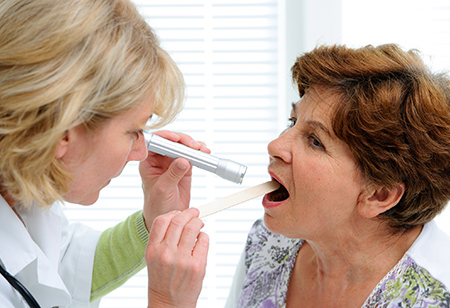Foluso Ogunleye, MD, an independent member of the HonorHealth medical staff, is a hematologist and oncologist for HonorHealth Cancer Care. He shares his knowledge of head and neck cancers in this Q&A.
Q. How common are head and neck cancers?
A: They're not uncommon. Each year in the U.S., 63,000 cases are diagnosed; approximately 13,000 deaths are reported annually.

Q. What are the different types of head and neck cancers?
A: Head and neck cancers are classified and named according to their location.
- Cancer in the oral cavity (mouth) includes lip and tongue cancer.
- Cancer from the base of the skull to the hard/soft palate is called nasopharyngeal cancer.
- Oropharyngeal cancer involves cancer on the base of the tongue, tonsils, the part of the throat behind the mouth and the soft palate at the back of the mouth.
- Cancer in and around the vocal cords is called hypopharyngeal cancer.
- You can also develop cancer in your salivary glands.
Q. What are some signs and symptoms of head and neck cancers?
A: If you have head or neck cancer, you may experience:
- Tongue pain.
- A growth on the tongue or lip.
- Plaque thrush on the tongue (leukoplakia).
- Ear pain.
- Hearing loss.
- Tinnitus.
- Nasal obstruction.
- Loosening of teeth.
- Difficulty swallowing or painful swallowing.
- A neck mass.
- A hoarse voice.
- Weight loss and/or poor appetite.
Q. What are risk factors for head and neck cancers?
A: You have a greater risk of developing head or neck cancer if you smoke tobacco or drink alcohol. Also, your risk for oropharyngeal cancer goes up if you've had a human papilloma virus (HPV) infection. Your risk for nasopharyngeal cancer increases if you've had the Epstein-Barr virus. Other risk factors for head and neck cancers include:
- Immunodeficiency due to HIV infection or solid organ transplantation.
- Chewing on betel nuts (grown and consumed throughout the tropical Pacific).
- Exposure to environmental toxins.
- Radiation exposure.
- Genetic factors, such as Fanconi anemia, a rare disease that mostly affects the bone marrow.
- Chronic use of mouthwash that contains alcohol (used for more than 35 years and more than once a day).
- Poor oral hygiene.
- Periodontal disease.
Q. What are treatment options for head and neck cancers?
A: If you're diagnosed with head or neck cancer, your treatment options depend on the stage of the disease and location of the tumor. If you have early-stage disease that's localized, surgery is an option.
If surgery isn't possible due to the location of the cancer or involvement of lymph nodes, your doctor may recommend radiation therapy with or without concurrent chemotherapy (done at the same time), which is the standard of treatment.
For nasopharyngeal cancer, the standard of treatment is radiation with concurrent chemotherapy instead of surgery. If you have more advanced disease that has spread, the standard of treatment is combination chemotherapy in which more than one chemo drug is used. If the disease progresses or doesn't respond to treatment, your doctor may prescribe immunotherapy.
Q. What can you do to help prevent head and neck cancers?
A: To reduce your risk of developing head and neck cancers:
- Avoid smoking and excessive alcohol consumption.
- Practice safe sex (oral sex increases the risk of HPV infection).
- Get tested for HIV if you have a high-risk sexual lifestyle (and get treated if you are HIV-positive).
- Practice good oral hygiene.
- Visit the dentist regularly.
- Protect yourself in the workplace if you have potential exposure to carcinogens.
Q. When should you call your doctor?
A: Call your doctor if you notice any growth on your lips or tongue that won't go away, worsening hoarseness of your voice, or difficult or painful swallowing.
If you've been diagnosed with cancer, call 1-855-485-4673 to get an appointment with an HonorHealth provider – within 48 hours, if desired. Please note that you'll need a referral from your primary care physician, specialist or diagnostic imaging center.